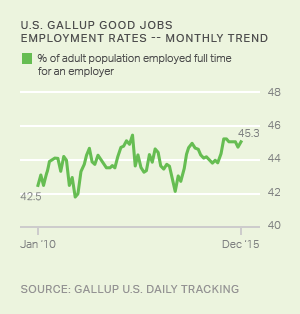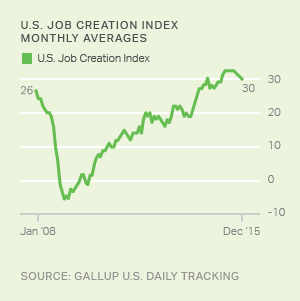Story Highlights
- Minnesota (+38) edges out Georgia, Utah (+36)
- Alaska ranks last, at +12
- Most states' scores went up in 2015, many energy-producing states down
PRINCETON, N.J. -- Minnesota led the 50 states on Gallup's Job Creation Index with an average score in 2015 of +38, based on workers' reports of hiring activity at their place of employment. Georgia and Utah were next at +36. North Dakota, which had been the top overall state each of the last six years, remains in the top 10.

The remainder of the top-performing states include Delaware, Nebraska, Nevada, Oregon and Wisconsin. The five states tying for 10th place are Arizona, Florida, Michigan, Ohio and Washington.
In 2015, an average of 46% of working Minnesotans said their place of employment was hiring workers and expanding the size of its workforce, compared with 8% who said their employer was letting workers go and reducing the size of its workforce. This results in a Job Creation Index score of +38 for Minnesota. Nationally, the average score for 2015 was +30 (42% hiring, 12% letting go). The results for each of the 50 states are presented at the end of the article.
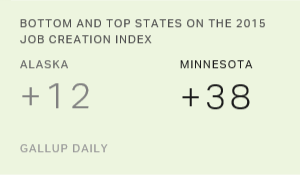
Minnesota, with a 3.5% unemployment rate, added more than 40,000 jobs last year, according to state officials, with the biggest job gains in education and health, leisure and hospitality, and professional and business services.
This is the third time Minnesota has placed in the top 10 states since Gallup began tracking the Job Creation Index in 2008. Minnesota was also in the top 10 in 2012 and 2013, while just missing the cut in 2014. North Dakota and Nebraska are the only states that have ranked among the top 10 states in job creation each year in Gallup's eight-year trend.
Nevada showed the most growth in net job creation last year, with its 13-point increase exceeding Minnesota's 10-point gain. No other state saw a double-digit increase on this metric. Nevada now ranks among the top 10 states for the first time; it had been among the bottom 10 states each year from 2008 through 2011 after being hit especially hard by the housing bust and recession.

Each night in its Daily tracking survey, Gallup asks employed Americans to report on hiring activity at their place of work. The data reported here are based on interviews with more than 200,000 U.S. workers, including at least 581 in every state. Forty-two states had sample sizes larger than 1,000. Gallup weighted each state sample to ensure it is representative of the state's adult population.
Alaska Ranks 50th in Job Creation
Alaska had the lowest Job Creation Index score in 2015 at +12, with 31% of working Alaskans saying their employer was hiring workers and 19% saying it was letting workers go. West Virginia was next at +18, followed by Wyoming at +20. Connecticut ranked in the bottom 10 again -- the only state to finish in the bottom 10 each of the eight years of Gallup's trend.
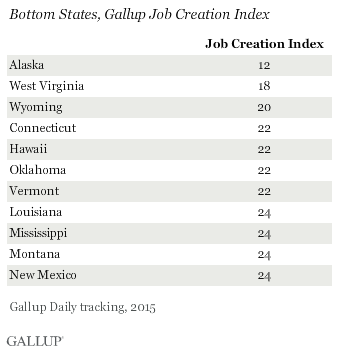
Many of the bottom 10 states are reliant on energy production to support their states' economies, which are beginning to suffer as a result of low gas prices over the past 16 months. In 2015, when Gallup's Job Creation Index hit new highs nationally, only nine states failed to see improvements from 2014. Most of those are energy-producing states, including North Dakota -- which still ranks in the top 10 even though it fell from first place -- but also several of the lowest-ranking states, including Alaska, Wyoming, Oklahoma and Louisiana.
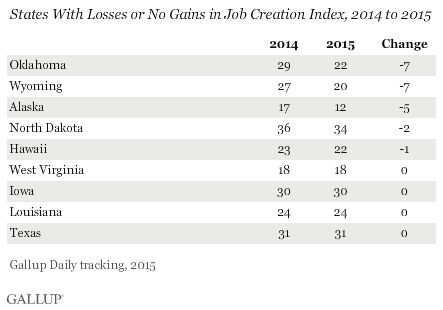
The impact of the boom-and-bust energy market on certain state economies is further indicated by the fact that many of the states now ranking in the bottom 10 in job creation ranked among the top 10 states when energy prices were high in 2008. Alaska did not rank among the top states in 2008 but did so in 2009, 2010 and 2011.
Regional Patterns
There are no obvious regional patterns in above-average hiring activity, defined as states that are more than four points above the national average of +30. Each region has at least one state ranking above the average, including Delaware in the East, Georgia in the South, Minnesota and Nebraska in the Midwest and Utah, Nevada and Oregon in the West.

There is a cluster of states with below-average Job Creation Index scores in the Gulf Coast and Southwest, including Louisiana, Mississippi, Oklahoma and New Mexico. New England has two below-average states in Connecticut and Vermont. Both Alaska and Hawaii have below-average scores.
Implications
The U.S. unemployment rate in 2015 declined to levels not seen since before the recession, and Gallup's Job Creation Index established new national highs, but not every state enjoyed a strengthening job market. Although even the bottom-ranking states on Gallup's job creation measure are still experiencing an expansion of jobs, some states, particularly those reliant on energy production, saw a weaker jobs picture in 2015 than in 2014.
The weaker performance in energy-producing states presents an interesting economic challenge, as low gas prices benefit consumers, but at the same time, they are not good for energy companies or the Americans who work for them. That also underscores the vulnerability of state and local economies reliant on a specific industry. When that industry struggles, the local economy will as well. A diversified economy is the way to avoid booms and busts, although diversification may be a goal easier aspired to than achieved in reality.
Another pattern in these trends offers some encouragement for struggling states. The track record of Gallup's job creation data indicates that states with low job creation at one point in time can recover quickly. Nevada, Delaware and Michigan were among the poorest-performing states on this metric from 2008 through 2011 and now rank among the best.
These data are available in Gallup Analytics.
Survey Methods
Results for this Gallup poll are based on telephone interviews conducted Jan. 1-Dec. 31, 2015, on the Gallup U.S. Daily survey, with a random sample of 203,484 employed adults, aged 18 and older, living in all 50 U.S. states and the District of Columbia. For results based on the total sample of working adults, the margin of sampling error is ±1 percentage point at the 95% confidence level.
Margins of error for individual states are no greater than ±6 percentage points, and are ±3 percentage points in most states. All reported margins of sampling error include computed design effects for weighting.
Each sample of national adults includes a minimum quota of 60% cellphone respondents and 40% landline respondents, with additional minimum quotas by time zone within region. Landline and cellular telephone numbers are selected using random-digit-dial methods.
Learn more about how Gallup Daily tracking works.

